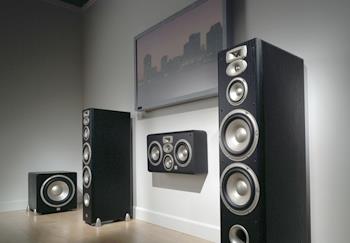JBL Studio L Speakers: L890 Floor-Standing Towers, LC2 Center, L830 Bookshelves, and L8400P Subwoofer Part I June, 2006 Adrian Wittenberg
|

Introduction
I have had experience with JBL loudspeakers in the past and have been impressed with what the brand offers in terms of price versus sound quality. So, when I was given the opportunity to review a performance line JBL speaker system, I gladly accepted and eagerly awaited their arrival.
The Studio L series is new for JBL in that it is the first of their consumer lineup to utilize ultrahigh frequency transducers that were previously only found in JBL's professional studio monitors. The ultrahigh transducers that JBL uses are said to extend the upper frequency range to 40 kHz. Although human hearing is usually defined as having an upper limit of 20 kHz, there are some data showing that we can somehow "sense" frequencies higher than that.
To accomplish this extended upper range, a ¾" Mylar dome transducer plays into a Bi-Radial® horn waveguide, and it is accompanied by a 1" pure titanium dome transducer which plays into an EOS™ Waveguide.
The EOS™ or Elliptical Oblate Spheroidal waveguide is intended to control the sound dispersion so that it radiates the sound directly toward the listening area rather than letting it reflect off of the sidewalls. These two transducers are present on each of the JBL Studio L models except for the L8400P subwoofer. The idea of using an ultrahigh transducer playing into the Bi-Radial ® horn waveguide is the same kind of idea you see on JBL's ultra high end K2 9800 series.
The Studio L series also features a few wall-mountable models for flexible positioning. These include the LC2 center channel speaker, the L810 bookshelf monitor, and the L820 bookshelf monitor. The way they look when mounted on a wall can be seen in the photo at the beginning of this review.
Another design concept used in the Studio L line of loudspeakers is that of the PolyPlas cone driver. This is a cellulose fiber-based (paper) cone that is reinforced with a polymer (plastic) coating. The polymer coating is intended to retain the tonality characteristics of a paper-based cone while supplementing the rigidity and damping qualities of the material. Personally, I like the characteristics of paper-based drivers because they can add warmth to instruments like cellos, saxophones, and guitars.
The Studio L series are available in a couple different configurations. The setup I chose to review consists of the L890 tower speaker as the front left/right speakers, the LC2 as the center channel, the L830 bookshelf speakers as the surrounds, and the L8400P for the subwoofer. The review speakers that arrived were finished in a black ash, which from a distance looks like a satin black, but from up close has a wood grain. The whole system has a very contemporary appearance and would integrate well with other modern electronics. The speakers are also available in cherry, or beech finishes for those who wish to have more of a natural look
A Couple of Specifics
All models except the L8400P have gold plated five-way binding posts to make them bi-wireable. The L890 is a four-way floor standing tower which is rated at 91dB sensitivity with power handling of 125 watts – 250 watts. The relatively high sensitivity and nominal impedance of 8 ohms makes them likely candidates for most mass market receivers.The LC2, L810, and L820 can be wall mounted by using the keyhole mounting holes on the back of the speaker. One would install pan head screws into the wall preferably where there is a wall stud, and then those would in turn fit inside the keyholes on the back of the speaker and hold them in place. A template is included with the manual to guide you with drilling holes.
The Low End
The L8400P subwoofer features a 600 watt digital amplifier and a 12" PolyPlas cone driver housed in a sealed enclosure. Other features include a vented pole piece, a cast-aluminum frame, and a motor assembly which utilizes JBL's symmetrical field geometry design that is used to keep the magnetic force even during the movements of the voice coil. This is intended to keep distortion to a minimum.It also has a 00-1800 phase switch, adjustable low pass of 50 Hz to 150 Hz, and speaker-level inputs as well as outputs (high pass to small speakers).
Some of the features I would have liked to seen on this subwoofer are individual dial markings on the crossover knob and a detachable power cord.
Set-upListening was done in my living room which opens into a kitchen. The speakers were set up with the L890s placed on the sides of my 65" rear projection TV and toed in about 100. The L8400P subwoofer was placed in the front right corner of the room, and the LC2 center channel speaker was placed on a stand in front of the television. The L830s were placed on speaker stands behind the listening position and pointing sideways. I used an AVIA set-up disc to calibrate everything before listening.


